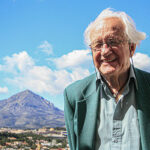Spirituality and Peace
EDITORIAL, 28 Aug 2023
#811 | Prof. Johan Galtung – TRANSCEND Media Service
28 Aug 2023 – Our world is clearly missing something, in fact much, in its efforts to achieve peace. And one of them is expressed by the word “spirituality”, about as overused as the word “peace” precisely because they both embody so many of our dreams.
Having spent much time demystifying peace (50 Years: 25 Intellectual Landscapes Explored, TRANSCEND University Press), how about demystifying spirituality?
It is inner life. It is deep, reflective, also self-reflective. It is beyond the body, and beyond the mind, capable of reflecting on the pains and pleasures of the body, and, more difficult, on the deep forces down in our minds and in our social context. Freud, Jung and Marx come to our mind among the guides; three geniuses whose spirituality lifted us all to see so that we could think, speak, act — in a new way.
Like the Christ, or Lord Buddha.
They made us capable of reflecting, and reflecting on, something beyond our individual self and our collective Self, something “trans”. Trans what? Beyond what? Maybe an answer could be beyond anything, that the very essence of the spiritual is exactly to go beyond, to transcend.
In doing so there is an effort to liberate the concept from the solid monopoly religion has had on everything spiritual while at the same time keeping that connection, in no way denying the enormous significance of religion, re-ligare, reconnect. No “deligion”, de-ligare, disconnect completely from “that out there” will ever succeed. But what is it, “that out there”?
Let us start with mathematics, science and art. Where does spirituality enter in these largely secular pursuits?
Spirituality enters when an Einstein or a Picasso forge time and space into deeper unions, or a mathematician creates a new math with the old ones as special cases. To step beyond natural numbers, inventing negative numbers, coming up with the transcending concept of integers, is deeply spiritual.
It means lifting the spirit above where we were; seeing, feeling, thinking the unseen, the unfelt, the unthought. For Einstein space and time, seen from his genial above, coalesced into a space-time continuum. For Picasso a two-dimensional canvas suddenly made a jump and became, at least, three-dimensional. Spirituality is jumpy, revolutionary, it is a step function in mathematics, not continuous.
It happens more frequently at some times than others, more to some than to others. It can be learnt, trained. Mediation is one approach, clearing the mind of the many assumptions that cloud the slate, making us ready for the jump. Mediation, mediated knowledge, is another, giving us ladders to climb, or some ropes to hang on to, hoping they will not hang us instead. They do not exclude each other.
It happens in love, the union of body, mind and spirit; sex, harmony, cooperation. Truly revolutionary. Sex as parallel masturbation is not spiritual; in the spiritual there is always something beyond the sum of the part(ner)s. Harmony is joint empathy, suffering the suffering of the other, enjoying the joy of the other, it is beyond mutual liking and sympathy. Cooperation is not to work parallel, making money, managing the oikos, household; it is a joint project for mutual and equal benefit, creating a we, not two I’s. A marriage opens for boundless spirituality, a union of three unions; only that we poor humans are not always up to it.
Enters religion, like Hamlet’s ghost. The seat of spirituality? Yes, and no. Religion comes in two shapes, hard and soft, strongly related to whether “that of God” is transcendent, above, like Father-Sky, or below, like Mother-Earth; or “that of God” is immanent, in us all. We sense two forms of religious spirituality, reaching, lifting ourselves for union with God out there, or for union with all others imbued with divine spirit, the we. And we sense two, maybe three, forms of salvation after biological death: union with that Father in heaven; union with Mother earth (which is what funerals are about); and union with that We, with Life, the most inclusive, with all humans who ever were, are or will be; or only with our own in-group, the most exclusive.
Enters peace, Hamlet’s other ghost. And we can sense a connection, but not quite simple. For spirituality to be a key to peace it has to be inclusive. It can be based on religion or on anti- or a-religion. It can be transcendent, meaning based on something beyond us, like higher forces or principles. Or it can be immanent, based on that We, the unity-of-humans Gandhi talked about, the Ubuntu of the Zulus.
But for spirituality to spell peace it has to be inclusive. We cannot do with a transcendent Father who has his Chosen People, maybe gender, race, class etc. Then Mother Earth is more generous: she tends to receive us all. And we cannot do with an immanent divinity for the in-group only.
The spiritual has to transcend our small persons, go beyond and encompass all humanity and earth and sky with it.
And that makes hard religion an enemy of peace and soft, inclusive religion its friend. Tell me your spirituality, and I will tell how much peace there is in you.
__________________________________________
This TMS Editorial was first published on 28 Aug 2008, #21.
 Johan Galtung, a professor of peace studies, dr hc mult, is founder of TRANSCEND International, TRANSCEND Media Service, and rector of TRANSCEND Peace University. He was awarded among others the 1987 Right Livelihood Award, known as the Alternative Nobel Peace Prize. Galtung has mediated in over 150 conflicts in more than 150 countries, and written more than 170 books on peace and related issues, 96 as the sole author. More than 40 have been translated to other languages, including 50 Years-100 Peace and Conflict Perspectives published by TRANSCEND University Press. His book, Transcend and Transform, was translated to 25 languages. He has published more than 1700 articles and book chapters and over 500 Editorials for TRANSCEND Media Service. More information about Prof. Galtung and all of his publications can be found at transcend.org/galtung.
Johan Galtung, a professor of peace studies, dr hc mult, is founder of TRANSCEND International, TRANSCEND Media Service, and rector of TRANSCEND Peace University. He was awarded among others the 1987 Right Livelihood Award, known as the Alternative Nobel Peace Prize. Galtung has mediated in over 150 conflicts in more than 150 countries, and written more than 170 books on peace and related issues, 96 as the sole author. More than 40 have been translated to other languages, including 50 Years-100 Peace and Conflict Perspectives published by TRANSCEND University Press. His book, Transcend and Transform, was translated to 25 languages. He has published more than 1700 articles and book chapters and over 500 Editorials for TRANSCEND Media Service. More information about Prof. Galtung and all of his publications can be found at transcend.org/galtung.
Tags: Conflict Mediation, Love, Meditation, Metaphysics, Peace, Peacebuilding, Spiritual Science, Spirituality
This article originally appeared on Transcend Media Service (TMS) on 28 Aug 2023.
Anticopyright: Editorials and articles originated on TMS may be freely reprinted, disseminated, translated and used as background material, provided an acknowledgement and link to the source, TMS: Spirituality and Peace, is included. Thank you.
If you enjoyed this article, please donate to TMS to join the growing list of TMS Supporters.

This work is licensed under a CC BY-NC 4.0 License.

Through the Dialogue on Peace Education between the Author of these lines Dr. Surya Nath Prasad and the Anchor of the UCN News Channel, Dr. Prasad strongly supports the views of Prof. Johan Galtung, the Pioneer of Peace Studies, expressed in his Editorial of Transcend Media Service on Spirituality and Peace.
A Dialogue on
Peace Education
By Surya Nath Prasad, Ph.D.
https://www.youtube.com/watch?v=LS10fxIuvik
I was blessed, for no quality of mine, to find a guru in Johan.
We are such a short time in the River of Life, why can we not all enjoy the journey in harmony with one another?
The last four paragraphs are inspirational for me. Being a-religious, I have often wondered if I lack spirituality. Galtung has reassured me.
Thank you, Prof. Galtung. I often recall your lectures at the U of Hawaii back in the ’90s. They were eye-opening for me.
One of the biggest challenges for human beings now is to understand that spirituality is not equivalent to religiosity. For some people who read or listen to Prof. Galtung explaining this, it’s like writing on water, but for many like me, it’s clear like a full moon reflecting on water. I particularly embrace his formulation of We, because that approach lifts us to the same category as a seed, with that life force inside that is transformational and has potential.